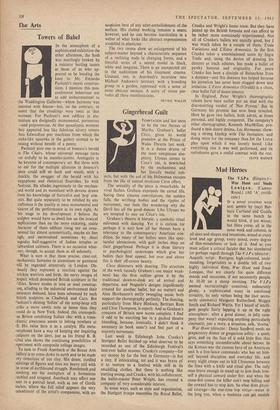Gingerbread Guilt
TEMPTATION and lust seem to be the two themes of Martha Graham's ballet Circe, given its world premiere at the Prince of Wales Theatre last week. It is a dance drama of the most sumptuous sim- plicity. Ulysses comes to Circe's isle, is bewitched by the enchantress and her literally bestial sub-
jects, but with the aid of his Helmsman escapes from the life of animal eroticism Circe offers.
The sexuality of the piece is remarkable. In vivid flashes, Graham expounds the carnal life. Seeing these sinuous convolutions, the sudden falls, the writhing bodies and the ripples of movement, one feels like wondering why the .Devil has all the good dances. Like Ulysses we are tempted to stay on Circe's isle.
Graham's theatre is hieratic, a symbolic ritual enlivened with dancing. Yet it is curious (or perhaps it is not) how all her themes have a relevance to the contemporary American con- dition. So many of her ballets seem like spec- tacular abreactions, with guilt inches deep on their gingerbread. Perhaps it is these literary or psychological undertones which give her ballets their final appeal, but over and above this is their off-centre beauty.
Circe shimmers with dancing. The structure of the work (usually Graham's one major weak- ness) has the firm outline given it by the traditional dawn-to-dusk arc of arrival and departure, and Noguchi's designs (significantly created for another ballet, but no matter) and Alan Hovhaness's eerily twangling music both support the choreography perfectly. The dancing, particularly from Mary Hinkson, Bertram Ross and Clive Thompson, is superb. And so Graham's conquest of Britain now seems complete. I find it odd to be watching her in a packed theatre (standing, because, ironically, I didn't think it necessary to book seats!) and feel part of a majority movement.
Last week in Edinburgh John Cranko's Stuttgart Ballet finished up what deserves to be recorded as one of the Edinburgh Festival's best-ever ballet seasons. Cranko's company—for my money by far the best in Germany—is but a tiny, if intoxicating, tot and it was brave of it to venture to a festival while still in its swaddling clothes. But there is nothing like starting young, and Cranko, with his collaborator, the ballet-master Peter Wright, has created a company of very considerable interest.
In some ways, such as style and organisation, the Stuttgart troupe resembles the Royal Ballet, Cranko and Wright's home team. But they have jazzed up the British formula and can afford to be rather more consciously experimental. Not all of Cranko's ballets are equally good, but I was much taken by a couple of them, Trede Variations and L'Estro Armonico. In the first Cranko takes a commissioned score by Ingre Trede and, using the device of dressing his dancers as track athletes, has made a ballet of pawky humour and originality. For years Cranko has been a disciple of Balanchine from a distance—and this distance has helped because his invention has never been clogged down into imitation. L'Estro Armonico (Vivaldi) is a clean, clear ballet full of dance interest.
In England, Peter Wright's choreographic talents have been earlier put on trial with the disconcerting verdict of 'Not Proven.' But in Germany his promise has now been revealed. Here he gave two ballets, both adroit, at times personal, and highly competent. The company's other choreographer, Kenneth MacMillan, pro- duced a taut dance drama, Las Hermanas, show- ing a strong kinship with The Invitation, and doing more for the company than for the Lorca play upon which it was loosely based. Like everything else it was well performed, and its melodrama gave a useful contrast with the rest.
CLIVE BARNES






























 Previous page
Previous page